Canon Science Lab
Television and Liquid Crystal Displays
What other kinds of light do we see everyday? TVs and LCDs are both forms of artificial light indispensable in our daily lives.
The most widely used information display device to date has been the cathode ray tube (CRT) TV. Recently, LCDs have been rapidly gaining popularity. LCDs are extremely versatile because they can be used not only in TVs, but also in cellular phones, mobile devices, notebook computers, game consoles, digital cameras, car navigation systems and other devices. CRTs and LCDs may resemble each other in appearance and how they work, but their structures and principles differ. Let's take a look at how they work.
CRTs Are Lit Using Electron Beams
The CRT in a TV is a glass vacuum tube. The inner surface of the screen is coated with tiny phosphor dots that emit light in the three primary colors (red, green, and blue). These phosphor dots glow when struck by an electron beam, resulting in the images we see on screen. The electron beam is a focused stream of electrons pouring off an electrode to which negative voltage is being supplied.
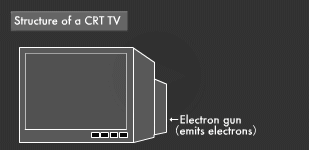
The electrons emitted from the so-called electron gun strike the phosphor dots, causing them to glow. Deflection coils that create magnetic fields are used to enable the electron beam to strike any phosphor dot on the screen. The CRT TV has 525 scan lines on the screen. The electron gun "draws" odd lines, followed by even lines, 60 times a second. In short, we perceive the three glowing primary colors produced by the electron gun's drawing process as a continuous image. The drawbacks of CRT TVs are the high voltage required to emit electrons and the large, heavy devices they require, such as the electron gun. Furthermore, in order for the scanning lines to travel over large screen areas, a certain distance is required between the electron gun and the screen, effectively limiting how thin CRT TVs can be made.
LCDs Contain Liquid Crystals
LCDs are rapidly becoming a part of our daily lives, but have you ever considered what exactly they are? The liquid crystal of an LCD is a material in an intermediate state between solid and liquid. Sepia and soapsuds are familiar examples resembling such materials. An LCD is a device that sandwiches liquid crystals between two sheets of material. Liquid crystal was discovered in 1888 by Austrian botanist Friedrich Reinitzer (1857-1927).
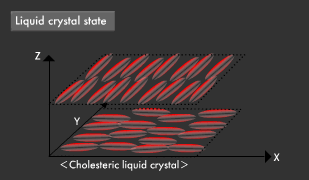
While he was observing cholesteryl benzoate, Reinitzer noticed that it went through two stages. At 14 degrees Celsius, it went from a solid to a cloudy fluid (liquid crystal), and at 179 degrees Celsius it became a clear liquid. It was later learned that such state changes were due to the change in the arrangement of molecules within substances. A liquid consists of molecules that flow and are in a disorganized state. When a liquid becomes a solid, the molecules lose their fluidity and fall into an orderly arrangement. In liquid crystal state, molecules are arranged with moderate but not complete regularity. LCDs employ this liquid crystal property.
LCDs produce images by using liquid crystals to either transmit or block light. Liquid crystals used in displays must have their molecules arrange in an orderly fashion at room temperature and also react sensitively to voltage, changing their orientation. Liquid crystal molecules have a rod-like shape. Explained simply, when these rods are arranged horizontally, light from the bottom cannot pass through. When they are arranged vertically, however, light can pass through. The angle at which the rods are arranged defines the level of brightness in between. Using voltage to control the way these rods are arranged is the basic principle behind LCDs.
LCDs Have a Sandwich Structure
The structure of LCDs is a combination of liquid crystals sandwiched between two clear panels and polarizing filters that allows light to pass through in only one direction. The light source is a lamp positioned behind the display. Fluorescent lamps are commonly used in direct-view displays. Most calculators and watches use reflective panels that can be viewed when enough surrounding light is available. The polarizing filter can pass only the light component from the light source that is parallel to the direction of its axis, and the molecular arrangement of liquid crystals determines whether that light passes through them or is blocked. This structure can represent white/black by turning power on/off. Adding red, green, and blue filters enables display in color.

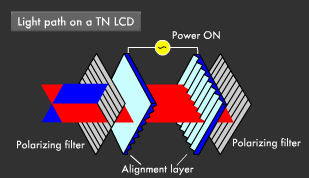
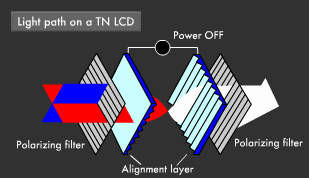
Let's take a closer look at the structure of an actual LCD. The two panels sandwiching the liquid crystals are grooved. They are formed so that the liquid crystal molecules line up along the grooves. The liquid crystals are sandwiched by arranging these two panels with their grooves crossed at right angles, causing each layer of liquid crystals molecules to gradually twist until the top layer is at a 90-degree angle to the bottom one. The axis of the light vibration that has passed through the polarizing filter is also twisted 90 degrees as it travels through these liquid crystals. Since the alignment direction of liquid crystal molecules depends on voltage, applying voltage causes them to line up along the electric field and untwist, also allowing light to be untwisted. The light that passes through the first polarizing filter will be blocked by the second polarizing filter and will not go through. This is the basic principle of a twisted nematics (TN) LCD. In STN LCDs, the angle of twist is 120 degrees or more.
LCDs Until Today
Actually, LCDs did not come into practical use until relatively recently. After Reinitzer's discovery in 1888, liquid crystals did not attract much attention again until the 1960s. In 1963, RCA researcher Richard Williams discovered that applying voltage to liquid crystals changed how light passed through them, and in 1968, another RCA researcher, George Heilmeier, applied this principle to create a display device. It took until 1978 before an LCD could be commercialized.

The gap between development and commercialization was due to the need for advances in semiconductor electronics before LCDs could become practical. To draw complex images on an LCD, there must be electrodes that can turn on/off on each tiny grid square (called a pixel) on the screen, thereby controlling whether light does or does not pass through. Furthermore, color display requires the addition of color filters on the pixels. LCDs with several tens of thousands of pixels capable of displaying beautiful high-resolution images would have been impossible to make without the application of photolithography, which is used in the manufacture of semiconductor integrated circuits.
Various Types of Displays (Plasma Displays)
As liquid crystal displays have continued to increase in size, large-screen televisions measuring more than 40 inches have gained widespread popularity. In fact, there are even many models available now that measure more than 80 inches in size.
Like liquid crystal displays, plasma displays are another type of flat-panel display (FPD) technology used to produce large-screen, thin-body displays. Plasma displays apply the principle of fluorescent light emitted by the discharge phenomenon.
The cells in plasma display panels are injected with rare gas elements such as xenon.
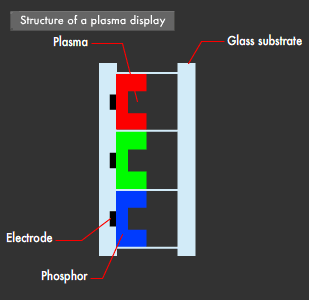
When electrons are emitted due to a current passing through the electrodes forming the cells, these collide with the atoms making up the gas, resulting in electrons being separated from the atom and entering an unstable excited state. When they return to their ground state from the excited state, energy is emitted as light.
Since this light is ultraviolet light, it is not white light. Each cell in the panel is divided into three parts, and fluorescent material for the three colors of RGB is applied to these. Color is emitted by the fluorescent material to display colors. Color adjustment is controlled through light intensity and white results when the intensity of the three colors is uniform. Black is produced when none of the colors are illuminated.
Various Types of Displays (OLED Displays)
The principle used for emitting light in displays varies depending on the format. Liquid crystal displays require a white light source as a backlight in addition to the material used (liquid crystal). Cathode ray tubes emit light using accelerated electrons. Plasma displays use ultraviolet light emitted by electric discharges. If it were possible to emit RGB light by applying a current to a combination of materials with different properties like an LED, it may be possible to create a display in which each element emits its own light with very little electrical energy.
There is much anticipation that OLED (Organic Light Emitting Diode) displays will serve as such self-emitting displays. The material used is an organic compound.
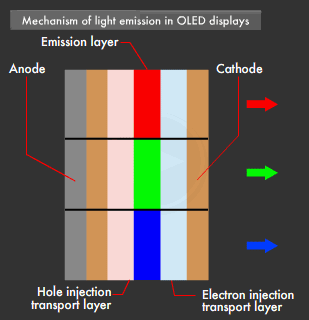
Organic compound refers to compounds (other than CO, CO2, etc.) containing carbon (C), and a typical example of a familiar organic compound is plastic. It is also possible to create inorganic light emitting diode displays using inorganic compounds, but as they would not operate stably for prolonged periods when using a direct current, the practical application of OLED displays that include materials that are able to operate with low-voltage direct currents has begun.
The structure of an OLED display is shown below. When voltage is applied between the electrodes on both sides (negative electrode and positive electrode), the electrons emitted by the negative electrode are injected into the emission layer by the electron injection transport layer. Meanwhile, on the positive electrode side, the "holes" created by the removal of electrons are injected into the emission layer by the hole injection transport layer. Electrons and holes enter an excited state when recombined in the emission layer, and light is emitted when they return to their ground state. The color emitted is determined by the wavelength of the light emitted by the substance used as the material.
A variety of materials have been tested for use in OLED displays. At present, the technology has seen practical applications in select televisions as well as compact displays for mobile phones, and has also been commercialized as a new type of lighting called flat lights. Much research is being conducted on materials and manufacturing methods with an eye to supporting large screens and flexible displays.
